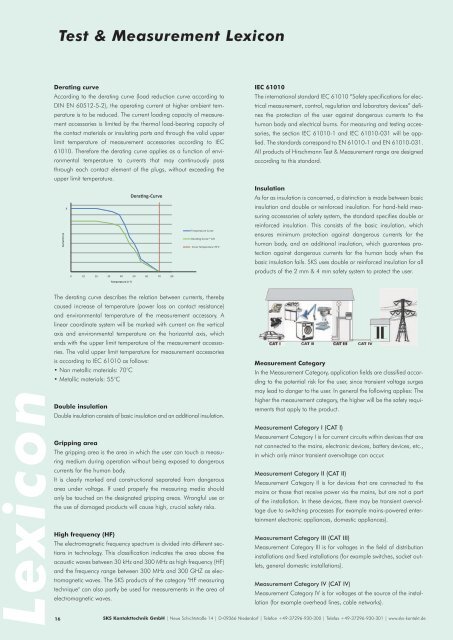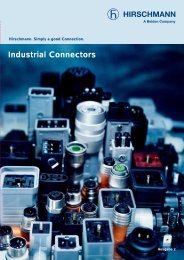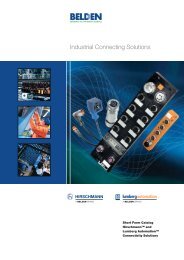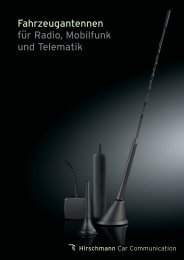Test & Measurement Lexikon - Triax
Test & Measurement Lexikon - Triax
Test & Measurement Lexikon - Triax
Erfolgreiche ePaper selbst erstellen
Machen Sie aus Ihren PDF Publikationen ein blätterbares Flipbook mit unserer einzigartigen Google optimierten e-Paper Software.
<strong>Test</strong> & <strong>Measurement</strong> Lexicon<br />
Derating curve<br />
According to the derating curve (load reduction curve according to<br />
DIN EN 60512-5-2), the operating current at higher ambient temperature<br />
is to be reduced. The current loading capacity of measurement<br />
accessories is limited by the thermal load-bearing capacity of<br />
the contact materials or insulating parts and through the valid upper<br />
limit temperature of measurement accessories according to IEC<br />
61010. Therefore the derating curve applies as a function of environmental<br />
temperature to currents that may continuously pass<br />
through each contact element of the plugs, without exceeding the<br />
upper limit temperature.<br />
Derang-Curve<br />
Current in A<br />
X<br />
Temperature Curve<br />
Derang-Curve * 0,8<br />
Cross Temperature 70°C<br />
0 10 20 30 40 50 60 70 80<br />
IEC 61010<br />
The international standard IEC 61010 “Safety specifications for electrical<br />
measurement, control, regulation and laboratory devices” defines<br />
the protection of the user against dangerous currents to the<br />
human body and electrical burns. For measuring and testing accessories,<br />
the section IEC 61010-1 and IEC 61010-031 will be applied.<br />
The standards correspond to EN 61010-1 and EN 61010-031.<br />
All products of Hirschmann <strong>Test</strong> & <strong>Measurement</strong> range are designed<br />
according to this standard.<br />
Insulation<br />
As far as insulation is concerned, a distinction is made between basic<br />
insulation and double or reinforced insulation. For hand-held measuring<br />
accessories of safety system, the standard specifies double or<br />
reinforced insulation. This consists of the basic insulation, which<br />
ensures minimum protection against dangerous currents for the<br />
human body, and an additional insulation, which guarantees protection<br />
against dangerous currents for the human body when the<br />
basic insulation fails. SKS uses double or reinforced insulation for all<br />
products of the 2 mm & 4 mm safety system to protect the user.<br />
Temperature in °C<br />
Lexicon<br />
The derating curve describes the relation between currents, thereby<br />
caused increase of temperature (power loss on contact resistance)<br />
and environmental temperature of the measurement accessory. A<br />
linear coordinate system will be marked with current on the vertical<br />
axis and environmental temperature on the horizontal axis, which<br />
ends with the upper limit temperature of the measurement accessories.<br />
The valid upper limit temperature for measurement accessories<br />
is according to IEC 61010 as follows:<br />
<strong>Measurement</strong> Category<br />
• Non metallic materials: 70°C<br />
In the <strong>Measurement</strong> Category, application fields are classified according<br />
to the potential risk for the user, since transient voltage • Metallic materials: 55°C<br />
surges<br />
Double insulation<br />
Double insulation consists of basic insulation and an additional insulation.<br />
Gripping area<br />
The gripping area is the area in which the user can touch a measuring<br />
medium during operation without being exposed to dangerous<br />
currents for the human body.<br />
It is clearly marked and constructional separated from dangerous<br />
area under voltage. If used properly the measuring media should<br />
only be touched on the designated gripping areas. Wrongful use or<br />
the use of damaged products will cause high, crucial safety risks.<br />
High frequency (HF)<br />
The electromagnetic frequency spectrum is divided into different sections<br />
in technology. This classification indicates the area above the<br />
acoustic waves between 30 kHz and 300 MHz as high frequency (HF)<br />
and the frequency range between 300 MHz and 300 GHZ as electromagnetic<br />
waves. The SKS products of the category "HF measuring<br />
technique" can also partly be used for measurements in the area of<br />
electromagnetic waves.<br />
may lead to danger to the user. In general the following applies: The<br />
higher the measurement category, the higher will be the safety requirements<br />
that apply to the product.<br />
<strong>Measurement</strong> Category I (CAT I)<br />
<strong>Measurement</strong> Category I is for current circuits within devices that are<br />
not connected to the mains, electronic devices, battery devices, etc.,<br />
in which only minor transient overvoltage can occur.<br />
<strong>Measurement</strong> Category II (CAT II)<br />
<strong>Measurement</strong> Category II is for devices that are connected to the<br />
mains or those that receive power via the mains, but are not a part<br />
of the installation. In these devices, there may be transient overvoltage<br />
due to switching processes (for example mains-powered entertainment<br />
electronic appliances, domestic appliances).<br />
<strong>Measurement</strong> Category III (CAT III)<br />
<strong>Measurement</strong> Category III is for voltages in the field of distribution<br />
installations and fixed installations (for example switches, socket outlets,<br />
general domestic installations).<br />
<strong>Measurement</strong> Category IV (CAT IV)<br />
<strong>Measurement</strong> Category IV is for voltages at the source of the installation<br />
(for example overhead lines, cable networks).<br />
16 SKS Kontakttechnik GmbH | Neue Schichtstraße 14 | D-09366 Niederdorf | Telefon +49-37296-930-300 | Telefax +49-37296-930-301 | www.sks-kontakt.de







